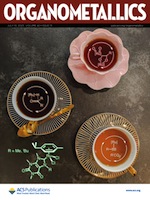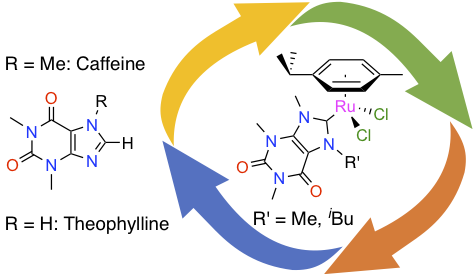"“Greening” Ruthenium-Arene Catalyst Precursors with N-Heterocyclic Carbene Ligands Derived from Caffeine and Theophylline"
François Mazars and Lionel Delaude
 |
source: Organometallics
year: 2023
volume: 42
first page: 1589
last page: 1597
doi: 10.1021/acs.organomet.3c00166
|

Abstract: Two ruthenium-arene complexes with the generic formula [RuCl2(p-cymene)(NHC)] were readily obtained from natural, abundant, and renewable methylxanthine alkaloids used as N-heterocyclic carbene (NHC) precursors. After optimization, the known compound Ru-1 featuring the 1,3,7,9-tetramethylxanthine-8-ylidene ligand was isolated in three steps and 72% overall yield starting from caffeine. Four steps were needed to synthesize complex Ru-2, which sported the bulkier 7-isobutyl-1,3,9-trimethylxanthine-8-ylidene ligand, in 41% overall yield starting from theophylline. Multinuclear NMR analysis confirmed the presence of p-cymene and an NHC ligand within the coordination sphere of both products. Yet, they exhibited a significantly different dynamic behavior in solution at room temperature, due to the larger size of the isobutyl chain compared to a methyl group, which severely restricted the rotation of the arene ligand and caused a loss of symmetry. Complexes Ru-1 and Ru-2 were both highly active catalyst precursors for the transfer hydrogenation of unsaturated substrates with isopropanol under basic conditions (11 examples). They were also efficient promoters for the oxidation of styrene or α-methylstyrene with sodium periodate. Last but not least, they triggered the synthesis of vinyl esters from 1-hexyne and benzoic acid. For this later reaction, the product distribution varied markedly with the nature of the NHC ligand. Altogether, this study demonstrated that the combination of a labile p-cymene ligand and an ancillary NHC ligand derived from caffeine or theophylline provided an efficient and sustainable access to a wealth of highly active Ru-hydride, -oxo, or -alkyne species that were able to catalyze three miscellaneous organic transformations.
[Full Text] [<< Previous Article] [Back to the List of Publications] [Next Article >>] l.delaude@ulg.ac.be